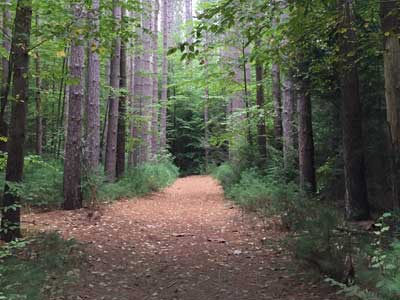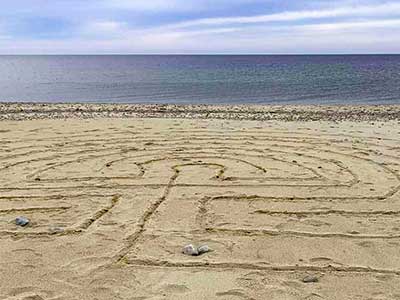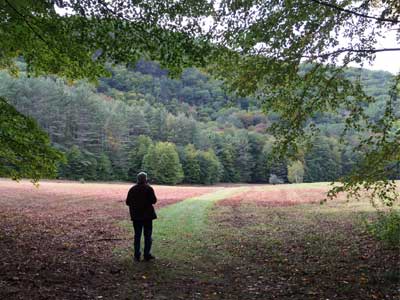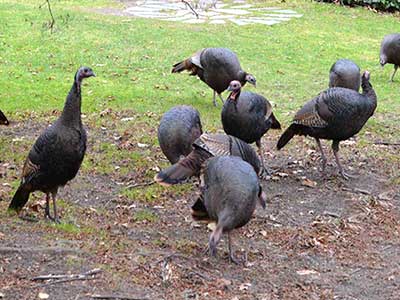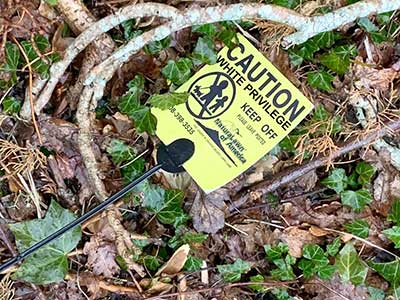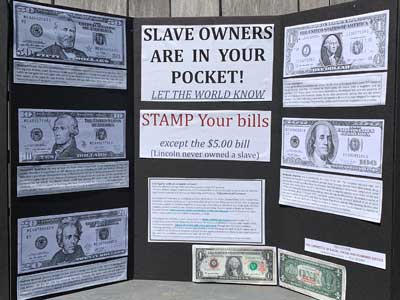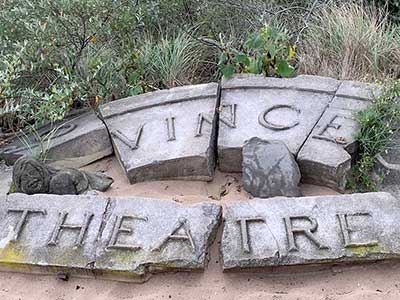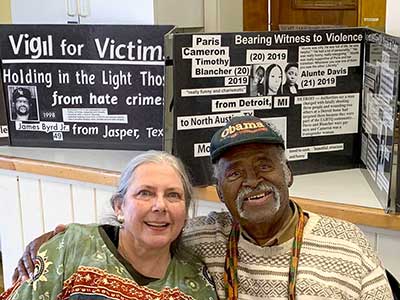by Rebecca Onion | April 2021
The Ledger and the Chain tells the story of how these three men profited from the United States’ decision to outlaw the foreign slave trade, in 1808. The change, of course, did not put an end to slavery inside the United States, and because the slaveholding states of the Upper South were finding that their land was increasingly difficult to work after decades of tobacco cultivation, they profited by selling people further South, where cotton and sugar production was booming. …
This dynamic is most visible in the traders’ letters discussing teenage girls who were sold as sex slaves. In trading these young women, identifiable in documentation by their much-higher-than-usual prices (and, sometimes, by the traders’ explicit discussion of their likelihood to sell for those purposes), Franklin, Armfield, and Ballard prided themselves on their ability to know what buyers might want—their success “speculating on the erotic desires of slaveholders.” They also raped such women, themselves; Rothman found many ribald references to those activities in their own correspondence, interspersed with discussions of everyday business matters.
TAGS: [Racial Terrorism] [2020’s] [Slavery] [History] [Systemic Racism] [Black Lives Matter] [White Supremacy] [White Culture] [White Privilege] [Social Justice] [Politics]
Resource Links Tagged with "Slavery"
Black Soldiers Played an Undeniable but Largely Unheralded Role in Founding the United States; Veterans like Prince Hall Fought for Independence and then Abolition in the Earliest Days of the Nation
by David A. Taylor | February 2021
Just after dawn on Christmas Day 2020, Clarence Snead Jr., received a phone call with harrowing news: The Prince Hall Masonic Lodge in Providence, Rhode Island, was ablaze. Snead, whose nickname is “Grand” (for “Most Worshipful Grand Master”), rushed the half-hour drive to the lodge on Eddy Street and found the building engulfed in flames. The lodge had a remarkable history that a passerby might not suspect from the two-story wooden structure; a destructive blaze would strike a terrible blow for historic preservation. It housed one of the earliest organizations established by African Americans, stretching back to the era of Prince Hall, a black Bostonian and Revolutionary War veteran. Hall started the first lodge for black Freemasons in his home city in the 1770s with a charter obtained from British Freemasons, because Massachusetts’ white Masonic brethren rejected his application. The arc of Hall’s life and legacy point to the underappreciated role played by African Americans in the Revolution, an indication that the path to black civil rights is as old as the nation itself.
TAGS: [Strategies] [2020’s] [History] [Black Lives Matter] [Slavery] [Social Justice] [White Supremacy] [Indigenous]
158 Resources to Understand Racism in America
by Meilan Solly | June 2020
Amid escalating clashes between protesters and police, discussing race—from the inequity embedded in American institutions to the United States’ long, painful history of anti-black violence—is an essential step in sparking meaningful societal change. To support those struggling to begin these difficult conversations, the Smithsonian’s National Museum of African American History and Culture recently launched a “Talking About Race” portal featuring “tools and guidance” for educators, parents, caregivers and other people committed to equity. “Talking About Race” joins a vast trove of resources from the Smithsonian Institution dedicated to understanding what Bunch describes as America’s “tortured racial past.” From Smithsonian magazine articles on slavery’s Trail of Tears and the disturbing resilience of scientific racism to the National Museum of American History’s collection of Black History Month resources for educators and a Sidedoor podcast on the Tulsa Race Massacre, these 158 resources are designed to foster an equal society, encourage commitment to unbiased choices and promote antiracism in all aspects of life. Listings are bolded and organized by category.
TAGS: [Collective Action] [2020’s] [Systemic Racism] [Anti-Racism] [Policing] [Teachers] [History] [Intersectionality] [Slavery] [Racial Terrorism] [Black Lives Matter] [Civil War] [Politics] [Social Justice] [Racial Covenants] [Housing] [Employment] [Economics] [Silencing POC] [Health Disparities] [Prison System] [Implicit Bias] [Indigenous] [Police Shootings] [Latino/a] [White Supremacy] [White Culture]
Henry Ossawa Tanner: The Life and Work of a 19th-Century Black Artist
by Arnesia Young | February 2021
The 19th century was not an easy time to be a Black person in America, especially if you were trying to make it as an artist. For that reason, it is extremely remarkable to note when an American artist of African descent is able to rise above the racial discrimination so prevalent during that time period and become a renowned artist of international acclaim. Henry Ossawa Tanner was one such artist, and he was able to achieve that impressive feat during his lifetime. While he struggled with the complexities and the implications of his race and heritage, Tanner ultimately persevered and was able to develop his talent in a variety of genres. His artwork and story leave a lasting legacy that has impacted many Black artists who’ve followed since.
TAGS: [Strategies] [2020’s] [Art & Culture] [History] [Role Model] [Slavery] [Black Lives Matter]
The Crimson Klan
by Simon J. Levien | March 2021
When J. Max Bond Jr. ’55 entered Harvard at the age of 16, he was among 15 Black students in his class, most of whom lived in the north corner of Harvard Yard. As his freshman spring semester began, two other Harvard freshmen erected a wooden cross facing that corner of the Yard, formed by Stoughton and Holworthy Halls. And around midnight on Feb. 5, 1952, the students lit the cross on fire… Post-Harvard, Bond became one of a few prominent Black architects in the 20th century. After his death in 2009, his widow, Jean Carey Bond, released an 11-page retelling of his life. In it, Jean reveals that the University threatened Bond or any Black student with suspension should they go to the media with the cross burning. Bond, who graduated Phi Beta Kappa and finished undergrad in three years, was never suspended.
TAGS: [Racial Terrorism] [2020’s] [Systemic Racism] [Silencing POC] [White Supremacy] [White Culture] [White Privilege] [White Defensiveness] [History] [Slavery] [Denial] [Social Justice]
If You Truly Knew What the N-Word Meant to Our Ancestors, You’d NEVER Use It; It Was Used and Still Can Be Used to Make Us Hate Ourselves
by Brando Simeo Starkey | May 2017
A few years ago, I read slave narratives to explore the lives of black agricultural workers after the end of the Civil War. The narratives came from the Federal Writers Project of the Works Progress Administration, a program that employed researchers from 1936 to 1938 to interview former enslaved people, producing more than 2,300 narratives that, thankfully, reside online and are fully searchable.
TAGS: [Collective Action] [2010’s] [Slavery] [Civil War] [White Supremacy] [White Culture] [White Privilege] [Systemic Racism] [Definitions]
The Decline of Black Business; and What it Means for American Democracy
by Brian S. Feldman | May 2017
The last thirty years also have brought the wholesale collapse of black-owned independent businesses and financial institutions that once anchored black communities across the country. In 1985, sixty black-owned banks were providing financial services to their communities; today, just twenty-three remain. In eleven states that headquartered black-owned banks in 1994, not a single one is still in business. Of the fifty black-owned insurance companies that operated during the 1980s, today just two remain. Over the same period, tens of thousands of black-owned retail establishments and local service companies also have disappeared, having gone out of business or been acquired by larger companies. Reflecting these developments, working-age black Americans have become far less likely to be their own boss than in the 1990s.
TAGS: [Strategies] [2010’s] [Art & Culture] [Justice System] [History] [Economics] [Systemic Racism] [Black Lives Matter] [Social Justice] [Politics] [Slavery] [Civil War] [White Supremacy] [White Privilege] [Racial Covenants] [Racial Terrorism]
For White Allies on Black History and Slavery in the U.S.
(posted) by Paula M. Fitzgibbons | Date Unknown
Black history month is about so much more than slavery, but in the U.S., Black history and slavery are inseparable. And sadly, many of us still don’t have an adequate education on the topic. I’m always flabbergasted when I hear people say that Black Americans need to “get past” slavery. “It wasn’t us,” they say. “That happened hundreds of years ago. Get over it already.” It’s clear to me that these people don’t fully grasp the horror of American slavery, how long it lasted, and what happened after it. They also don’t seem to understand how severe trauma works.
TAGS: [Collective Action] [Slavery] [Black Lives Matter] [Systemic Racism] [White Fragility/Tears] [White Culture] [White Privilege] [White Defensiveness] [White Blindness] [Social Justice] [Racial Terrorism] [Silencing POC] [History] [Denial]
The Samuel George Morton CRANIAL COLLECTION; Historical Significance and New Research
by Emily S. Renschler and Janet Monge | Month Unknown 2008
Although few visitors to the Museum would know this, the Samuel George Morton cranial collection at the University of Pennsylvania Museum of Archaeology and Anthropology is one of the most famous collections of human skulls in the entire world. Its presence in Philadelphia is the result of the collecting activities of Samuel George Morton (1799–1851), a Philadelphian who actively participated in the vibrant medical and scientific community that spanned the Atlantic Ocean in the early 19th century.
TAGS: [Assumptions] [2020’s] [Art & Culture] [History] [Slavery] [Indigenous] [Black Lives Matter] [Latino/a] [Myths] [White Supremacy] [White Privilege] [White Culture] [Systemic Racism]
White Women’s Role in White Supremacy, Explained; Women at the Capitol Riot are Just the Latest Reminder of a Long History
by Anna North | January 2021
It’s tempting to think of the storming of the US Capitol on Wednesday as toxic masculinity run amok: a mob of mostly white men, carrying guns and wearing animal skins, trying to overthrow democracy on behalf of a president who once bragged about his ability to grab women “by the pussy.” It’s even more tempting to embrace this narrative when, in a bizarre statement, that president’s campaign press secretary describes him as “the most masculine person, I think, to ever hold the White House.”
But focusing too much on masculinity obscures a crucial truth: Many women were either present at the riot or cheering on the insurrectionists from back home. There was Ashli Babbitt, the 35-year-old Air Force veteran and apparent devotee of QAnon ideology who was killed during the riot. There was the woman photographed with “zip-tie guy” Eric Munchel, now believed to be his mother. There was Martha Chansley, the mother of the widely photographed “QAnon shaman” who wore a horned hat and carried a spear to Congress. She wasn’t present at the riot but later defended her son in an interview, calling him “a great patriot, a veteran, a person who loves this country.”
TAGS: [Assumptions] [2020’s] [White Supremacy] [White Culture] [White Blindness] [White Defensiveness] [White Privilege] [Politics] [Black Lives Matter] [Civil War] [Myths] [Slavery] [Economics] [History] [Calling Police] [Systemic Racism]
Why History Matters: the Legacy of Slavery
by David Rosen | January 2021
When recalling Lincoln, many New Yorkers may remember the famous speech he gave at Cooper Institute (aka Cooper Union) in February 1860 calling to limit the extension – but not the end – of slavery. It was a critical campaign speech that helped him secure the Republican Party nomination for President. In November, he was elected, and, in December, South Carolina was the first state to secede from the Union.
Unfortunately, few American – and likely very few New Yorkers – will recall that Lincoln’s speech was strongly attacked by city business leaders and the Democratic Party, many assailing him with the racist slogan, “Black Republican.” More important, Lincoln’s election sparked a strong movement in the city, led by Mayor Fernando Wood, to join the South and secede from the Union. This is one of the many important historical stories retold in an informative new book by Jonathan Daniel Wells, The Kidnapping Club: Wall Street, Slavery and Resistance on the Eve of the Civil War (Bold Type Books). Slavery was formally abolished in New York State in 1827, but the slave trade lived on in the city until the Civil War. Wells argues that the slave trade persisted in New York City in the decades before the Civil War because it was the capital of the Southern slave economy.
TAGS: [Strategies] [2020’s] [History] [Civil War] [Slavery] [Politics] [Social Justice] [Policing] [Black Lives Matter] [Justice System] [White Supremacy] [White Culture] [Silencing POC] [Racial Terrorism] [Social Justice]
Retracing Slavery’s Trail of Tears; America’s Forgotten Migration – the Journeys of a Million African-Americans from the Tobacco South to the Cotton South
by Edward Ball | November 2015
“My grandfather went to the folks who had owned our family and asked, ‘Do you have any documentation about our history during the slave days? We would like to see it, if possible.’ The man at the door, who I have to assume was from the slaveholding side, said, ‘Sure, we’ll give it to you.’ When Delores McQuinn was growing up, her father told her a story about a search for the family’s roots. He said his own father knew the name of the people who had enslaved their family in Virginia, knew where they lived—in the same house and on the same land—in Hanover County, among the rumpled hills north of Richmond.“The man went into his house and came back out with some papers in his hands. Now, whether the papers were trivial or actual plantation records, who knows? But he stood in the door, in front of my grandfather, and lit a match to the papers. ‘You want your history?’ he said. ‘Here it is.’ Watching the things burn. ‘Take the ashes and get off my land.’ “The intent was to keep that history buried,” McQuinn says today. “And I think something like that has happened over and again, symbolically.”
TAGS: [Racial Terrorism] [2010’s] [History] [Slavery] [Silencing POC] [Confederate Monuments] [Politics] [Black Lives Matter] [Definitions] [White Supremacy] [White Culture] [White Privilege] [Social Justice] [Civil War] [Accountability]
Whitesplaining Explained
by Chloe Edwards | February 2021
Mansplaining is a pejorative term used to describe the action of a man commenting on or explaining something to a woman in an often condescending or oversimplified way. … While there are obstacles for all women and stereotypes related to competence, Black women specifically face concrete ceilings that supersede gender as they are doubly oppressed. Black women are ranked the most educated group by race. … While many have heard of the terminology mansplaining, most may not be familiar with the concept whitesplaining. Whitesplaining is when white people condescendingly explain something — typically about race as well as other topics— to Black, indigenous or people of color. Whitesplaining shows up in a variety of common ways, so much so, the categories keep growing.
TAGS: [Assumptions] [2020’s] [Microaggressions] [Slavery] [Cognitive Dissonance] [White Supremacy] [Systemic Racism] [Black Lives Matter] [Implicit Racism] [Indigenous] [Colorblindness] [Tips-Dos/Don’ts]
Reparations Matter: Accountability Begins with Understanding
*Paywall Alert
by Douglas Haynes | February 2021
Last month’s violent insurrection at the US Capitol overshadowed the re-introduction of H.R. 40 on January 4, 2021. Introduced by Rep. Shelia Jackson Lee (D-Texas), this bill provides for funding for a commission to study and develop reparation proposals for African Americans. The two events could not be more different. One was a violent assault on the US Congress by extremists. The other reflected the deliberate law-making process of a modern democracy. In seeking to de-certify the votes of millions of Americans, the protestors sought nothing less than the restoration of white supremacy in the slogans “Make America Great Again” or “Take Back Our Country.” By contrast, the co-sponsors of the House bill called on the federal government to finally come to terms with the costs and consequences of the legal enslavement and differential treatment of Black people in both the past and present.
TAGS: [Strategies] [2020’s] [Reparations] [White Supremacy] [White Culture] [White Privilege] [Systemic Racism] [Black Lives Matter] [Social Justice] [Definitions] [Slavery] [Politics] [History]
Understanding Africa: Shattering Myths about the Culture of the Second-Largest Continent
by Aukram Burton | February 2021
African culture is vastly misunderstood in western societies. This misunderstanding continues to be perpetuated by educational and media institutions in the Western world that consistently misrepresent the image and contributions of African culture and ethics to the world. For centuries, European-centric thinking has justified colonialism and imperialism as a “civilizing mission” meant to save the African “savages” who live in “sh–holes” often characterized by terms like “exotic,” “primitive” or “pagan,” which is a misconception. This thinking is rooted in the age of European Enlightenment in the 17th and 18th centuries. This movement provided an intellectual backdrop for European theories about human differences.
TAGS: [Assumptions] [2020’s] [Myths] [History] [Definitions] [Slavery] [Systemic Racism] [White Supremacy] [Economics] [White Blindness]
A Forgotten Black Founding Father; Why I’ve Made it My Mission to Teach Others about Prince Hall
by Danielle Allen | March 2021
Many of us who live in Massachusetts know the basic outlines of this story and the early role the state played in standing against enslavement. But told in this traditional way, the story leaves out another transformative figure: Prince Hall, a free African American and a contemporary of John Adams. From his formal acquisition of freedom, in 1770, until his death, in 1807, Hall helped forge an activist Black community in Boston while elevating the cause of abolition to new prominence. Hall was the first American to publicly use the language of the Declaration of Independence for a political purpose other than justifying war against Britain. In January 1777, just six months after the promulgation of the Declaration and nearly three years before Adams drafted the state constitution, Hall submitted a petition to the Massachusetts legislature (or General Court, as it is styled) requesting emancipation, invoking the resonant phrases and founding truths of the Declaration itself.
TAGS: [Assumptions] [2020’s] [History] [Role Model] [Black Lives Matter] [Slavery] [Teachers] [Silencing POC] [-ing While Black] [Advocacy] [Systemic Racism] [Social Justice] [Civil War]
The Violent History of White Supremacy Is Rarely Taught in Schools. It Should Be.
by Corey Mitchell | January 2021
Searing images from this month’s mostly white insurrection in Washington, D.C.—including a hangman’s noose on the Capitol grounds and the Confederate flag carried inside the U.S. Capitol—harken back to another era when both were tools and symbols of white supremacy across the country. But relatively few students have learned about previous sordid moments that foreshadowed this year’s efforts to instill terror and violently overturn an election such as the Wilmington Insurrection of 1898, widely thought to be the only successful coup in U.S. history, and the Tulsa Race Massacre.
TAGS: [Racial Terrorism] [2020’s] [History] [Social Justice] [Systemic Racism] [White Culture] [Slavery] [Politics] [Denial] [Silencing POC] [Teachers] [White Supremacy] [White Privilege] [White Blindness] [White Defensiveness] [Black Lives Matter]
How U.S. Backed Banks Robbed Ex-Slaves of $66 Million
by Jared Brown | Month Unknown 2016
In 1871, Congress authorized banks to provide business loans and mortgages. Paradoxically, such mortgages and loans were usually administered to whites at the expense of black depositors. Risky investments and lending patterns, coupled with cronyism and corruption at the level of upper management, slowly undermined the stability of the bank. According to Black Past, “By 1874, massive fraud among upper management and among the board of director had taken its toll on the bank. Moreover, economic instability brought upon by the Panic of 1873, coupled with the bank’s rapid expansion, proved disastrous.” The Freedmen’s Bank was officially closed on June 29, 1874. At the point of closing, 61,144 black depositors were robbed of the modern equivalent of $66 million. The failure of the bank left many black depositors and borrowers distrustful of the white banking community, especially since the Freedmen’s Bank was established and managed by white men.
TAGS: [Strategies] [2010’s] [Systemic Racism] [History] [White Supremacy] [White Culture] [White Privilege] [Slavery] [Accountability] [Social Justice] [Economics] [Denial] [Racial Covenants] [Black Lives Matter]
Tignon Laws: The Dreadful Rule That Banned Black Women from Displaying Their Hair
by Farida Dawkins | February 2018
… there was a time when black women weren’t allowed to display their hair in public. Keep reading to learn about the Tignon Laws and how it was used to fuel racial tensions in the United States. A tignon (tiyon) is a headdress used to conceal hair. It was adorned by free and slave Creole women of African ancestry in Louisiana in 1786. The sumptuary law was enacted under Governor Esteban Rodriguez Miró. The regulation was meant as a means to regulate the style of dress and appearance for people of color. Black women’s features often attracted male white, French, and Spanish suitors and their beauty was a perceived threat to white women. The tignon law was a tactic used to combat the men pursuing and engaging in affairs with Creole women. Simply put, black women competed too openly with white women by dressing elegantly and possessing note-worth beauty.
TAGS: [Strategies] [2010’s] [Systemic Racism] [Silencing POC] [Black Lives Matter] [Definitions] [Denial] [White Supremacy] [White Privilege] [Slavery] [History]
‘A Missing Piece:’ Maine’s Connections to Slavery are Hidden in Plain Sight
*Paywall Alert
by Gilliam Graham | February Year Unknown
In July of 1750, a short notice appeared in a Boston newspaper calling for help finding an enslaved man who had run away from Ichabod Goodwin of Berwick in the province of Maine. Pompey was described as a short man of about 40 who spoke good English, wore a homespun jacket and checked shirt and had a cut ear. Fitted around his neck was an iron slave collar, a brutal device used by enslavers to identify and discipline the people they claimed as property. Goodwin, a blacksmith who offered a reward for Pompey’s return, likely made the collar himself. Notices like these of runaway slaves are among the few written documents that describe the reality and brutality of slavery in the early days of the Massachusetts Province of Maine. Largely left out of history books or minimized as an insignificant footnote, slavery remains a nearly hidden aspect of the history of Maine, a state better known as the home of abolitionists than enslavers or profiteers. However, reminders of Maine’s slavery connections linger in the coves, streets and other landmarks named for slaveholders who have been remembered instead for their contributions to shipbuilding, trade and establishing coastal towns.
TAGS: [Racial Terrorism] [Slavery] [Systemic Racism] [White Supremacy] [White Culture] [White Privilege] [Black Lives Matter] [History] [Social Justice]
Slavery and New York City; Confronting Our History to End the Narrative of White Supremacy
by Chuck Armstrong | February 2021
The Historical Society reports that during the colonial period of our country, 41 percent of households in New York City owned slaves, compared with 6 percent in Philly and 2 percent in Boston. “Only Charleston, South Carolina, rivaled New York in the extent to which slavery penetrated everyday life.” In a lot of ways, the life of the enslaved African in New York City looked different than in Charleston or elsewhere in the South; according to The New York African Free School, “Although New York had no sugar or rice plantations, there was plenty of backbreaking work for slaves throughout the state. Many households held only one or two slaves, which often meant arduous, lonely labor. Moreover, because of the cramped living spaces of New York City, it was extremely difficult to keep families together. It was not uncommon for owners to sell young mothers, because they did not want the noise and trouble of children in their small homes.”
TAGS: [Racial Terrorism] [2020’s] [White Supremacy] [History] [Slavery] [White Culture] [White Privilege] [Systemic Racism] [Anti-Racism] [Justice System] [Denial] [Racial Covenants] [Black Lives Matter]
8 Facts You Should Know about Racial Injustice in the Criminal Legal System; Racial discrimination Has Been Ingrained in the Criminal Legal System from Its Earliest Days and Persists Today.
by Daniele Selby | February 2021
The legacy of slavery, racist Jim Crow laws, and hateful lynchings has translated into modern-day mass incarceration and the disproportionate imprisonment of Black people. No where is that seen more clearly than in prisons like the Mississippi State Penitentiary — also known as Parchman Farm — and Louisiana’s Angola prison, which were built on and modeled after slave plantations and where several Innocence Project clients have been incarcerated. Racial discrimination and bias has been ingrained in the criminal legal and law enforcement system from its earliest days and continues to pervade every level of the system today. The Innocence Project, with your support, is committed to addressing these injustices. These eight statistics highlight the ways in which racial inequality persists in the criminal legal system today and contributes to wrongful conviction.
TAGS: [Strategies] [2020’s] [Slavery] [Justice System] [History] [Prison System] [Systemic Racism] [Social Justice] [Racial Bias] [Black Lives Matter] [Police Shootings] [Policing] [Accountability] [-ing While Black] [Racial Terrorism]
“I Am My White Ancestors” Claims the Legacy of Oppression; An Artist’s Journey into Her Family’s Whiteness
by Nancy Hill | March 2019
“I am about to turn over a goodly number of acres to cotton and have added more slaves to total 50. They were a large investment with housing and such. … We have heard that some states in the north have gone against nature and profit to prohibit slaves. … Without slaves, where do they expect to get cotton, tobacco, molasses, and rice? … Sometimes I do wonder if the slaves are truly as simple and childlike as some say. When I put some up for sale, I see their mothers stand there and openly weep. Imagine! Perhaps they really do feel as we do. But I banish that thought from my mind. … I am a good and kind master. These African slaves could not survive without me. They are better treated here than in the heathen land they come from. We clothe them and feed them, give them shelter and medical care and the discipline they need They have the benefit of civilized and white society.” —John Salley, 1740-1794, excerpt from audio story about Salley
TAGS: [Individual Change] [2010’s] [Slavery] [Systemic Racism] [White Supremacy] [White Culture] [White Defensiveness] [White Privilege] [White Blindness] [History] [Black Lives Matter] [Indigenous] [Art & Culture] [Anti-Racism]
Environmental Racism in Louisiana’s ‘Cancer Alley’, Must End, Say UN Human Rights Experts
by UN News | March 2021
The further industrialization of so-called “Cancer Alley” in the southern United States, known for its pollution-emitting chemical plants, should be halted according to a large group of independent UN human rights experts, who on Tuesday branded it a form of “environmental racism”. Originally dubbed “Plantation Country”, Cancer Alley, which is located in the southern state of Louisiana along the lower Mississippi River where enslaved Africans were forced to labour, serves as an industrial hub, with nearly 150 oil refineries, plastics plants and chemical facilities. The ever-widening corridor of petrochemical plants has not only polluted the surrounding water and air, but also subjected the mostly African American residents in St. James Parish to cancer, respiratory diseases and other health problems. “This form of environmental racism poses serious and disproportionate threats to the enjoyment of several human rights of its largely African American residents, including the right to equality and non-discrimination, the right to life, the right to health, right to an adequate standard of living and cultural rights”, the experts said.
TAGS: [Strategies] [2020’s] [Environment] [Health Disparities] [Slavery] [Black Lives Matter] [Social Justice] [Politics] [Systemic Racism] [White Supremacy] [White Culture] [White Privilege]
Mississippi School Asks Students to ‘Pretend’ to Be Slaves and Write Letters About Their ‘Journey’ to ‘Family Back in Africa’
by Zack Linly | March 2021
I don’t understand these “educators” who insist on taking slavery—the most brutal, cruel, and inhumane thing America has ever done to an entire race of people whose freedom, heritage, families and humanity were stripped from them—and turning it into some Sesame Street-ass game or activity that trivializes the centuries-long practice. Just last week, I reported on a school in Delaware in which kindergartners were being taught yoga positions that mimicked the way enslaved people were positioned on slave ships.
TAGS: [Collective Action] [2020’s] [Slavery] [Teachers] [Black Lives Matter] [Systemic Racism] [White Blindness] [White Culture] [White Privilege] [White Supremacy] [History] [Microaggressions] [Tips-Dos/Don’ts] [Accountability]
What Do We Do About John James Audubon?
by J. Drew Lanham | Spring 2021
The founding father of American birding soared on the wings of white privilege. The birding community and organizations that bear his name must grapple with this racist legacy to create a more just, inclusive world. Last summer, the Sierra Club denounced its first president, John Muir, as a racist unworthy of organizational adulation. Muir is a founding father of the American wilderness movement; he also characterized Blacks as lazy “sambos” and Native Americans as “dirty.” The National Audubon Society followed suit, stating that Audubon, too, was a racist. He enslaved at least nine people. He mostly referred to them as “servants” and “hands,” but never seemed especially concerned that the people helping him could be bought, sold, raped, whipped, or killed on a whim. Then again, relatively few men of his time did. Presidents did not. Why would he? Audubon’s callous ignorance wouldn’t have been unusual for a white man. It would have been de rigueur—an expectation of race and class that he enjoyed.
TAGS: [Collective Action] [2020’s] [Slavery] [History] [White Supremacy] [White Culture] [White Privilege] [Accountability] [Systemic Racism][-ing While Black] [Environment] [Myths] [Black Lives Matter] [Indigenous] [Implicit Bias] [Cognitive Dissonance] [Art & Culture]
Racial Discrimination Has Been ingrained in the Criminal Legal System from its Earliest Days and Persists Today
by Daniele Selby | February 2021
The legacy of slavery, racist Jim Crow laws, and hateful lynchings has translated into modern-day mass incarceration and the disproportionate imprisonment of Black people. No where is that seen more clearly than in prisons like the Mississippi State Penitentiary — also known as Parchman Farm — and Louisiana’s Angola prison, which were built on and modeled after slave plantations and where several Innocence Project clients have been incarcerated. Racial discrimination and bias has been ingrained in the criminal legal and law enforcement system from its earliest days and continues to pervade every level of the system today. The Innocence Project, with your support, is committed to addressing these injustices. These eight statistics highlight the ways in which racial inequality persists in the criminal legal system today and contributes to wrongful conviction.
TAGS: [Strategies] [2020’s] [Justice System] [Slavery] [Prison System] [Systemic Racism] [Social Justice] [White Supremacy] [White Culture] [White Privilege] [White Blindness] [Policing] [Implicit Bias] [Accountability] [Denial] [History] [-ing While Black] [Black Lives Matter]
Slavery Yoga Was Taught to Kindergarteners in Delaware for Black History Month. No, Seriously.
by Zack Linly | March 2021
Just Saturday, I wrote in a report that “It’s about time we have a serious conversation about how a lot of white teachers have no business whatsoever teaching Black students.” I based this statement on three separate stories—all of which occurred during this Black History Month—involving white teachers being racist while downplaying and/or distorting narratives around American racism during lectures to their students. Well, now there’s a fourth story—one that doesn’t necessarily feature educators denying the cruelty of slavery; they just made a fun game out of it which parents are rightfully calling “culturally insensitive, offensive” and “disturbing,”
TAGS: [Collective Action] [2020’s] [Teachers] [Slavery] [Black Lives Matter] [Systemic Racism] [White Blindness] [White Culture] [White Privilege] [White Supremacy] [History] [Microaggressions] [Tips-Dos/Don’ts] [Implicit Bias]
Teaching America’s Truth
*Paywall Alert
by Joe Heim | August 2019
For generations, children have been spared the whole, terrible reality about slavery’s place in U.S. history, but some schools are beginning to strip away the deception and evasions. “Think about this. For 246 years, slavery was legal in America. It wasn’t made illegal until 154 years ago,” the 26-year-old teacher told the 23 students sitting before him at Fort Dodge Middle School. “So, what does that mean? It means slavery has been a part of America much longer than it hasn’t been a part of America.” It is a simple observation, but it is also a revelatory way to think about slavery in America and its inextricable role in the country’s founding, evolution and present.
TAGS: [Assumptions] [2010’s] [Slavery] [History] [Collective Action] [Myths] [White Culture]
‘An Unbelievable Chain of Oppression’: America’s History of Racism was a Preexisting Condition for COVID-19
by Alan Gomez, Wyatte Grantham-Philips, Trevor Hughes, Rick Jervis, Rebecca Plevin, Kameel Stanley, Dennis Wagner, Marco della Cava, Deborah Barfield Berry, and Mark Nichols | October 2020
As the country cries out for a vaccine and a return to normal, lost in the policy debates is the reality that COVID-19 kills far more people of color than white Americans. This isn’t a matter of coincidence, poor choices or bad luck — it’s by design. A team of USA TODAY reporters explored how the policies of the past and present have made Black, Asian, Hispanic and Indigenous Americans prime targets for COVID-19. They found: America’s education and economic systems are still unequal, disproportionately leaving people of color out of higher-wage jobs. When COVID-19 struck, more people of color were serving as essential workers directly in the path of the virus.
TAGS: [Collective Action] [Health Disparities] [2020’s] [Black Lives Matter] [Indigenous] [Asian] [Latino/a] [Economics] [Employment] [Systemic Racism] [Denial] [History] [Social Justice] [Politics] [Justice System] [White Privilege] [White Culture] [White Blindness] [Housing] [Slavery] [Racial Covenants] [Environment] [Silencing POC]
